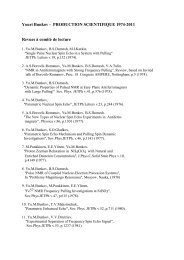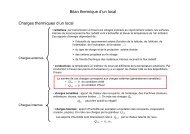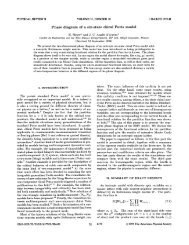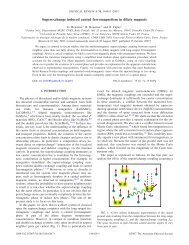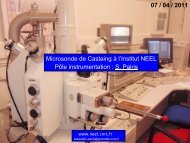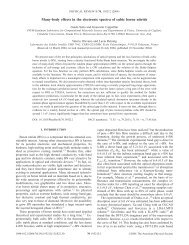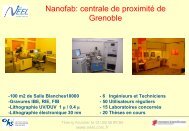Activity Report 2010 - CNRS
Activity Report 2010 - CNRS
Activity Report 2010 - CNRS
You also want an ePaper? Increase the reach of your titles
YUMPU automatically turns print PDFs into web optimized ePapers that Google loves.
8 – NANOMODELING,<br />
THEORY & SIMULATION<br />
Theory and simulation concerns about 50<br />
permanent researchers within the<br />
Nanosciences Foundation community.<br />
Theorists aim at developing new concepts<br />
and new tools while nurturing a strong<br />
coupling with experimentalists in<br />
Grenoble. This strong synergy has been<br />
supported and significantly improved by<br />
the Nanosciences Foundation.<br />
Several important scientific themes have<br />
benefited from the Foundation actions:<br />
electronic properties, thermal properties,<br />
growth patterning and structure. The<br />
Foundation had also enhanced the<br />
collaboration of simulation specialists<br />
through the NanoSTAR project.<br />
Electronic properties<br />
RTRA Project 2007: NanoSTAR<br />
Coordinator: Valerio OLEVANO (Institut<br />
Néel).<br />
PhD students: Bhaarathi NATARAJAN and<br />
Omid FAIZY NAMARVAR<br />
One of the two pillars of the NanoSTAR<br />
project deals with theoretical<br />
spectroscopy developments and their<br />
specific applications to nanomaterials and<br />
molecules. Bhaarathi NATARAJAN’s thesis<br />
work is focused on the development of<br />
new approximations for the exchangecorrelation<br />
(xc) kernel of time-dependent<br />
density-functional theory in order to<br />
explicitly include double excitations; and<br />
as second task, the implementation of<br />
such developments in a time-dependent<br />
density-functional theory code relying on<br />
a new basis set, that on the wavelets.<br />
These developments will improve the<br />
treatment of photochemical reactions<br />
which are at the heart of excitonic<br />
devices in particular for photovoltaic<br />
applications. In order to describe<br />
photoreactions by direct simulation one<br />
particular challenge is the description of<br />
the so-called conical intersection. These<br />
intersections between the fundamental<br />
state S0 and the excited state S1 are<br />
seen as the photochemical analogue of<br />
the transition state in thermal reactions.<br />
(Figure 1) The contribution of the team<br />
is an introduction of a spin-flip method.<br />
Fig. 1: Caption of a conical intersection. The<br />
graph represents the energy of the<br />
fundamental state S0 and the excited state S1<br />
in the configuration space obtained by<br />
different numerical methods.<br />
The other research line at the basis of the<br />
NanoSTAR project is quantum transport<br />
in nanodevices. This approach focuses on<br />
applications and methodological<br />
developments in general frameworks<br />
such as the Landauer-Buttiker or the<br />
Kubo-Greenwood. These techniques are<br />
applied to interesting new systems like<br />
graphene nanoribbons in presence also of<br />
defects and functionalisation. The work is<br />
carried out in collaboration by the Léti,<br />
INAC/SPSMS and Institute NEEL.<br />
Fig. 2: A methodology has been developed to<br />
treat the effect of contact resistance. This has<br />
been applied to short graphene nanoribbons<br />
connected to half graphene planes. Fabry<br />
Perot oscillations of the conductance, due to<br />
contact resistance, are predicted for armchair<br />
(up) and zig-zag (down) nanoribbons.<br />
The project also aims at developing new<br />
methodologies for transport of excitons in<br />
a given material. The methodology,<br />
which is adapted to small excitons, such<br />
as those found in organic semiconductors<br />
for example, is an extension of the<br />
methodology which has been highly<br />
successful for diffusion and conduction of<br />
electrons.<br />
FURTHER READING:<br />
CONTACTS<br />
Didier MAYOU<br />
didier.mayou@grenoble.cnrs.fr<br />
Tel: +33 4 76 88 74 66<br />
Gilles LECARVAL<br />
gilles.lecarval@cea.fr<br />
Tel: +33 4 38 78 54 62<br />
SCIENTIFIC REPORT<br />
Phys. Chem. Chem. Phys. 12, 12811<br />
(<strong>2010</strong>)<br />
Assessment of noncollinear spin-flip<br />
Tamm-Dancoff approximation timedependent<br />
density-functional theory<br />
for the photochemical ring-opening of<br />
oxirane<br />
Nanoresearch 3, 288 (<strong>2010</strong>)<br />
Quantum Transport Properties of<br />
Chemically<br />
Functionalized Long Semiconducting<br />
Carbon Nanotubes<br />
33



